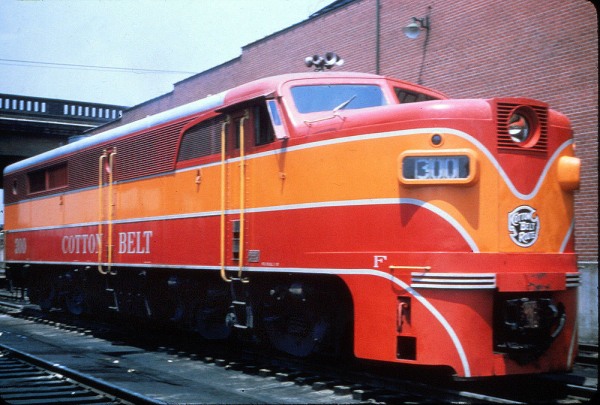Cotton Belt 300 Gets Around
I haven’t done an I Get Around post (a category that shows the same locomotive at a variety of locations) for some time. I was reminded of this recently when I was organizing SSW images and saw 4 of the same unit, SSW PA1 300.
The Cotton Belt owned 2 ALCO PA1’s, 300-301, acquiring them in 1949. They were delivered in Daylight colors, lettered St. Louis Southwestern. In late 1955, SSW chose to forgo its full company name on its diesels, re-lettering them with the line’s nickname, Cotton Belt. The work was done at the SSW shops in Tyler, Texas.
This first image shows SSW 300 at Texarkana in late 1955 / early 1956 shortly after being re-lettered.
By mid-1959, the only passenger service left on the Cotton Belt was between East St. Louis and Pine Bluff, #7 and #8. The 2 PA1’s and FP7A 306 were assigned to this service. As only one unit was needed for each train, the third unit would be used in freight service.
This next image shows SSW 300 in June 1959 departing Memphis with a Memphis – Pine Bluff manifest.
But the dual-service career of SSW 300 was short-lived. December 7, 1959 was the final run for SSW trains 7-8, ending the passenger era on the Cotton Belt. As Cotton Belt parent Southern Pacific still had plenty of work for passenger diesels, the decision was made to transfer the 3 SSW passenger diesels to the SP. They went to California, arriving in late December of 1959.
Once in California, the PA1’s were used mainly on Trains 90-91, the Coast Mail, an all-stops train between San Francisco and Los Angeles. They did see occasional duty on the Coast Daylight. Click here for more about the Coast Mail trains.

SSW PA1’s 300 and 301 lead train # 90, the southbound Coast Mail, on one of their first trips after being transferred from the Cotton Belt to the Southern Pacific.
SSW 300-301 were re-numbered SP 6067-6068 at the Taylor Yard roundhouse on January 13, 1960, less than a month after arriving out west, making the above image exceedingly rare.

Erstwhile SSW 300 and 301 sport their new SP numbers and lettering at Taylor Yard in mid-1960, shortly before being painted into SP scarlet and gray. Note the patched numbers on their flanks.
These 2 units would lose their Daylight colors shortly after the above image was made, receiving SP scarlet and red at the Taylor Yard paint booth in Summer of 1960. They would only run in their new colors for a bit more than 3 years, as they were retired in November, 1963.
 * Joe Strapac’s book, Cotton Belt Locomotives, was my primary source for the historical data.
* Joe Strapac’s book, Cotton Belt Locomotives, was my primary source for the historical data.



The B unit trailing #300 at Memphis is likely FTB #916.